The Samsung Galaxy Note5 and Galaxy S6 edge+ Review
by Joshua Ho on October 2, 2015 8:00 AM ESTDisplay
With the rise of smartphones and tablets, the display has become one of the most important aspects of a mobile device as it’s the primary mode of interaction. However, throughout computing the display has generally had relatively little attention. People might have talked about resolution, size, and latency, but the discourse was vague at best. In order to really understand displays, it’s important to discuss a number of factors that affect display quality and the underlying design of the display. These factors range from subpixel arrangement to TFT structure and various emitter materials. With traditional reviewing methods, it’s often difficult to say one way or another whether one display is “better” than another. While simple metrics like maximum brightness can be compared in a relative manner, it’s hard to say whether one has better colors or higher static contrast. In order to test these metrics, we turn to objective measurements from devices like X-Rite’s i1Pro2 spectrophotometer and i1Display Pro colorimeter. In order to acquire the data from these devices and present it in a usable manner, we use SpectraCal’s CalMAN 5 with a custom workflow.
Under the microscope and based upon some quick viewing angle tests, subjectively the Galaxy Note5 display looks and feels like a bigger version of the Galaxy S6 display. Viewing angles for some angles feels like the display is almost painted on to the glass below, but some odd interference effects with viewing angle changes breaks the illusion to some extent. In the case of the S6 edge+, the curved edges of the display cause a noticeable shift in luminance when looking at the edge compared to the center of the display, which also causes an odd green shift which is probably due to the RGBG subpixel layout. I suspect the best LCDs will still be better at the “painted to the glass” illusion for the near future. This isn’t a huge deal, but it is a noticeable difference.
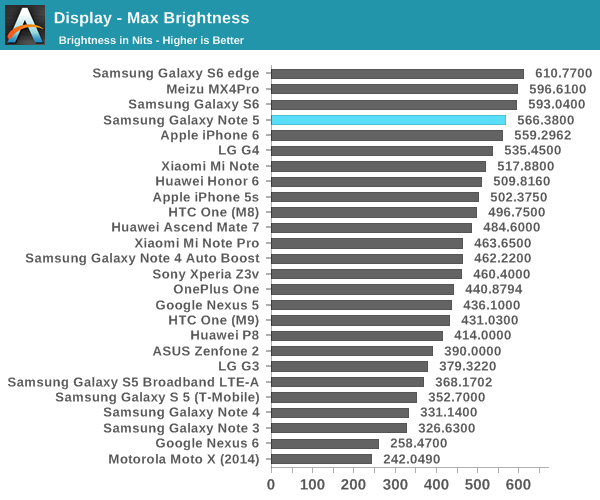
Moving on to our brightness testing, we can see that the Galaxy Note5 delivers a healthy improvement over the Galaxy Note 4 generation of AMOLED, but it isn’t quite at the same level as the Galaxy S6. It isn’t clear why this is the case, but I suspect this is related to longevity and other concerns outside of brightness. Meanwhile the use of OLED means that black levels are perfect and contrast remains solely determined by the lighting of the room and the reflectance of the display, which is similar to most other smartphones.
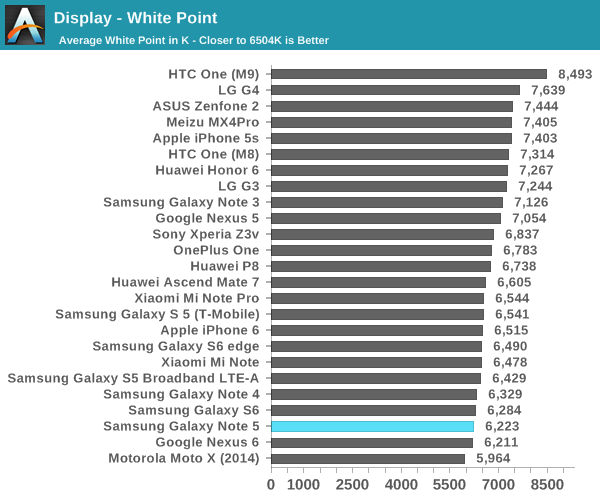
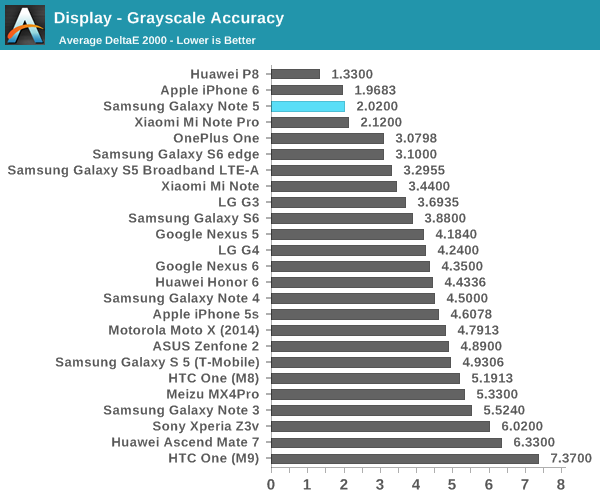
In our standard grayscale testing, the Note5 delivers acceptable color accuracy but it seems that the Basic screen mode tends towards a warm color balance. I suspect this helps with power efficiency, as blue in general requires more power to achieve the same level of luminance. Other than this slightly warm white balance, the grayscale accuracy doesn’t have any significant errors. This means accuracy ends up very good - certainly below our threshold for noticable errors - especially in comparison to the Galaxy Note 4 which had some noticeable problems with green tint on some units.
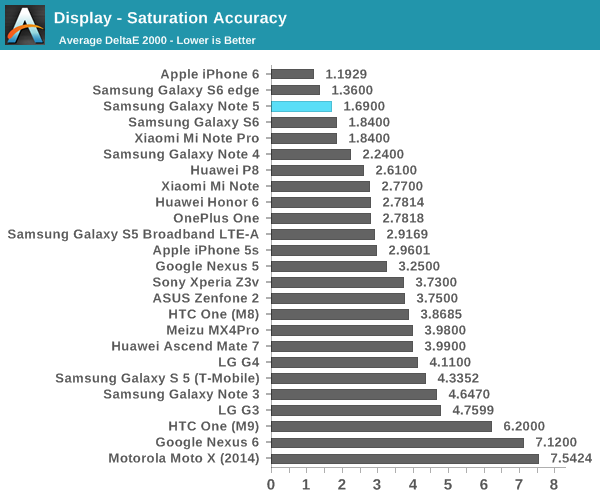
In our saturation test, Samsung does well enough that there’s really nothing to talk about because there's so little wrong here. You could argue that magenta is a bit warm on our review unit, but the difference is too small to be worth talking about. Error on average is going to be hard to spot unless you have a flawless reference monitor to compare against.
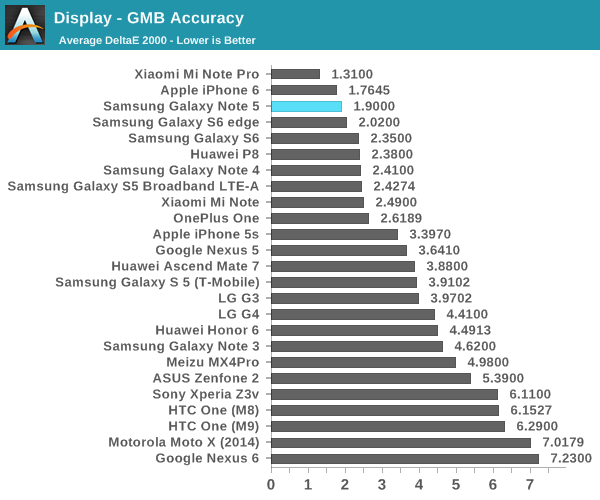
In the GMB ColorChecker test, Samsung continues to show a strong performance when looking at various hues that are commonly found in consumer content such as movies and camera photos. There’s a slight red shift on some of the tested hues, but the error is so minor I don’t notice that any problems here.
Overall, the Galaxy Note5 and Galaxy S6 edge+ both have an incredible display. The Galaxy S6 edge+ does have some problems with viewing angle shifts by virtue of the curved display, but this is effectively unavoidable given the subpixel layout and the radius of curvature. With this generation of AMOLED, Samsung has definitely equaled the best LCDs on the market. I suspect within the next year or two it will be inevitable that Samsung AMOLED will be clearly superior to even the best LCDs. However, without other OLED suppliers that can provide similar quality and cost I suspect OEM adoption will continue to be limited.



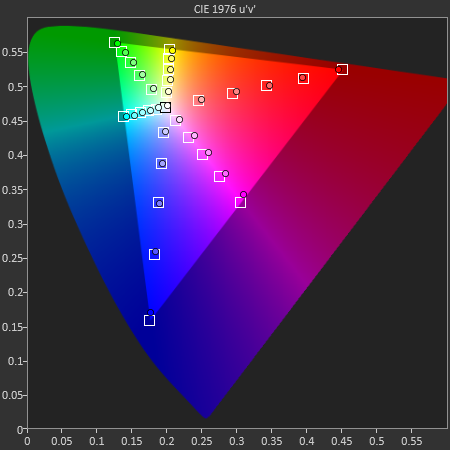
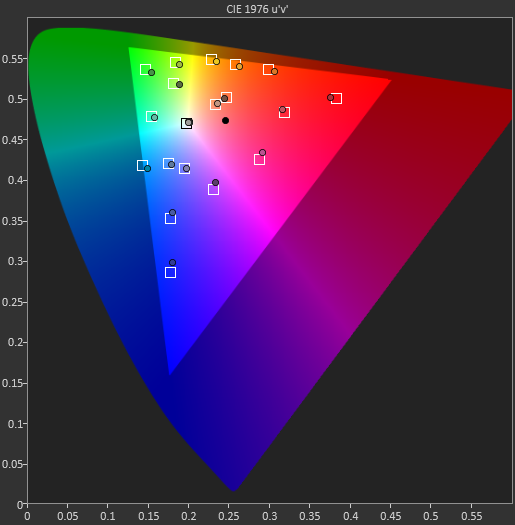








225 Comments
View All Comments
melgross - Saturday, October 3, 2015 - link
The fact that you are willing to admit that you don't like iOS shows your own bias. Your bias won't allow you to read a review that goes against your bias. That's why you, and those others here who are biased against iOS, and Apple in general, find reviews that show products that you are biased for, to be worse than the iOS products, you say that the reviews are biased, rather that your views of the reviews.So you would prefer all reviews to be biased towards the products you like.
Tough! The reviews stand as they are.
KoolAidMan1 - Saturday, October 3, 2015 - link
You're angry about perceived bias that runs counter to your personal bias, even when that "bias" is backed up by hard data?Really?
beggerking@yahoo.com - Sunday, October 4, 2015 - link
Well said. Anand had been extremely biased for years now.id4andrei - Friday, October 2, 2015 - link
Joshua, consider using Samsung's stock browser as it is better optimized. Vanilla Chrome is notorious for sucking hard across all Android devices. Apple optimizes constantly their web performance on mobile. Google does not care so much so Android OEMs have to go the extra mile.lopri - Friday, October 2, 2015 - link
I also thought that was an odd change/omission since those benches do not take very long to conduct.lilmoe - Friday, October 2, 2015 - link
It's very frustrating really. They did an article with the Note 4 showing that the stock browser (coupled with Exynos) is indeed more optimized. They then recently did an even more detailed technical article proving that Samsung's stock browser is MUCH faster and MUCH more efficient than Chrome, but then they completely ignore it and use Chrome...Oh well. I'm tired of asking them to do what they obviously DON'T want to do for whatever reason...
lopri - Friday, October 2, 2015 - link
This is the reason given by the same author as to why he used Samsung's stock browser in the S6/Edge review."As always, we'll start things off with our browser benchmarks. After getting to use the phone, it became clear to me that Chrome is poorly optimized against the Galaxy S6 as Samsung’s browser is clearly superior in performance. For that reason I've gone ahead and run our benchmarks on both Chrome and on the stock browser, as seen below."
http://www.anandtech.com/show/9146/the-samsung-gal...
So what changed?
lilmoe - Friday, October 2, 2015 - link
Thanks for contributing more evidence as to why Anandtech's comparison charts are an inconsistent mess."So what changed?" I'm assuming you mean what has changed between the GS6 on release and the Note5?
I don't know....... More software optimization? Newer build of Android? Battery life? Potentially better performance because of more thermal headroom? Take a pick.
I'm able to draw my own conclusions from certain reviews. But it's getting harder and much more frustrating with time.
Kuzi - Friday, October 2, 2015 - link
Guys I get 3900ms on my Galaxy S6 For Kraken 1.1 using stock browser.I also think it's odd since most Android makers already include a faster stock browser with their phones. But hey, this is the new iAnandtech after all :)
ws3 - Friday, October 2, 2015 - link
So If Anandtech used the stock browser, the Galaxy S6 would leapfrog the two year old iPhone 5s and be only 2.25 slower than the iPhone 6s.